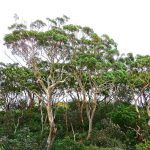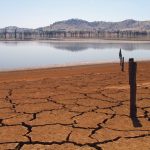 August 19, 2021 4:22 pm
Published by Climate Extremes
August 19, 2021 4:22 pm
Published by Climate Extremes
A three-year position is available in CMS after Annette Hirsch accepted a position with Deloitte. Meanwhile, CMS released a new version of CABLE-WRF, developed a data and code collection, redesigned training sources on the CMS wiki, and have helped create access to new configurations in ACCESS-ESM1.5.
 June 18, 2020 11:09 am
Published by Climate Extremes
June 18, 2020 11:09 am
Published by Climate Extremes
CLEX researchers implemented a new model of plant hydraulics into the Community Atmosphere Biosphere Land Exchange (CABLE) land surface model to robustly project future drought impacts on Australian vegetation.
 April 1, 2020 9:00 am
Published by Climate Extremes
April 1, 2020 9:00 am
Published by Climate Extremes
The drought may have finally eased over much of Australia, but it has resulted in a range of research that still continues. This research has opened new insights into how we understand the lifecycle of droughts in Australia. At the same time, continuing analyses of Australian models has produced improved configurations and even led to a new modelling framework for urban centres.
 October 25, 2019 12:23 pm
Published by Climate Extremes
October 25, 2019 12:23 pm
Published by Climate Extremes
With projected increases in temperature in the future, the amount of water vapour that can be held at saturation – before it condenses into clouds, dew or water film – increases exponentially. As this deficit increases plants tend to close their stomata, which reduces water fluxes into the boundary layer. Do models currently capture the observed leaf-level response to increasing vapour pressure deficit? What about at very high levels of this deficit?
 August 2, 2019 11:34 am
Published by Climate Extremes
August 2, 2019 11:34 am
Published by Climate Extremes
This release is to advise the community that an ACCESS Oversight Committee has been formed initially comprising Christian Jakob, Rachel Law, Helen Cleugh, Andy Pitman, Tony Hirst, Peter May, David Karoly and Ben Evans. Terms of reference have been agreed to by the group and can be found at the end of this document.
 July 11, 2019 2:32 pm
Published by Climate Extremes
July 11, 2019 2:32 pm
Published by Climate Extremes
The Postdoctoral Research Associate will work on a new ARC-funded project exploring how vulnerable Australia’s eucalypts are to future droughts. This project will combine data-synthesis, experimental manipulation and modelling to deliver new process-orientated insight into the response of eucalyptus trees to projected changes in the frequency, magnitude and duration of future droughts across Australia.
 March 27, 2019 11:32 pm
Published by Climate Extremes
March 27, 2019 11:32 pm
Published by Climate Extremes
The CMS team reports on a range of updates to ACCESS, NU-WRF (CABLE coupled to WRF), CMIP6 data, ERA5 datasets and more.
 March 30, 2018 6:21 am
Published by Climate Extremes
March 30, 2018 6:21 am
Published by Climate Extremes
In a major achievement, a version of the Australian community land model is now running in the ACCESS modelling system. This version includes the science advances led by Mark Decker around hydrology and soil evaporation, and the science advances led by Martin de Kauwe and Jatin Kala. It also includes major bug fixes identified by collaborators in the UK, and by colleagues in CSIRO. For the first time, we have a version of the Australian community land model coupled with an up to date version of the UK Meteorological Office’s atmosphere model.
 March 30, 2018 6:05 am
Published by Climate Extremes
March 30, 2018 6:05 am
Published by Climate Extremes
At this early stage in the research program, we have already seen significant progress on understanding how well temperature extremes can be simulated with CABLE coupled to the ACCESS system. Coupling has been improved and we have identified possible causes for the tendency for the model temperature to overstate extremes. This model focus will continue to be a priority in the early part of 2018.
The team has also identified specific continental heatwaves for initial investigation.









